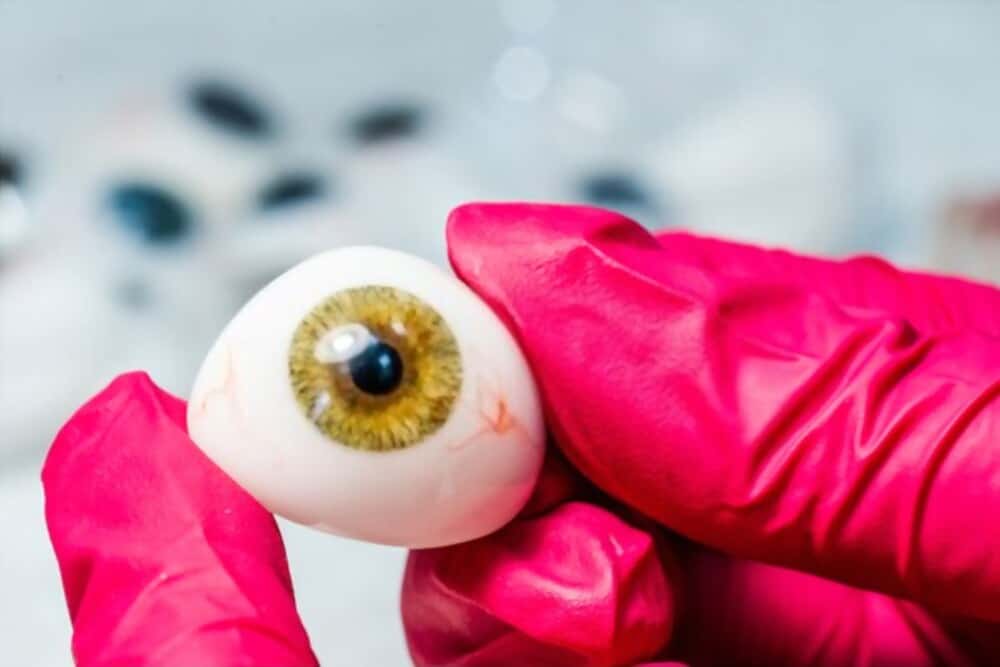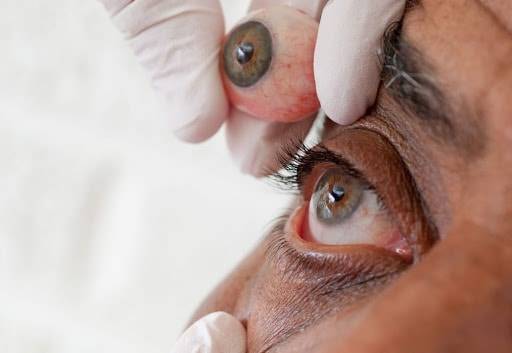Ocular Prosthesis
For a patient who unfortunately loses an eye to disease or trauma, the pain extends beyond the loss of the function itself. The continued suffering of a painful or disfigured eye, the social stigma, all lead to psychological setbacks for the patient.
The Ocularistry Service at Narayana Nethralaya, Bangalore, offers custom-made ocular prosthesis, which make for superior user-comfort and cosmesis as close to the natural eye as possible.
A custom-made prosthesis is an artificial eye made for the particular patient. Hence the size match and colour/appearance match are very good.
Oculoplasty

Rarely, a child is born with a missing eye or a very small disfigured eye. If the ophthalmologists examine and find there is no way of achieving functional vision in the eye, we can still help the child achieve good social outcome. The socket and eye are severely shrunken in these cases. This is treated with progressive socket expansion.
Images shows a patient with left custom made prosthesis.

Pre-Fitting Assessment
- Before fitting of the custom prosthesis, the socket is assessed to ensure it is healthy. There should not be any active infection or inflammation, excessive tenderness or sensitivity. The space available must be adequate, and the fornices well formed to support the prosthesis.
- The patient should report for an assessment of the socket or eye before the appointment for prosthesis is fixed, and any condition requiring treatment will be managed. A customised prosthesis may be fitted in most situations without further surgery. However, prior surgical procedures may be necessary in selected cases. This is called socket reconstruction surgery.

The Essentials
- Once the socket is assessed and found healthy, an impression is taken from the socket with alginate.
- A wax model of the eye is made, and the fit and centration determined.
- The white eye is fabricated from acrylic, which is biocompatible.
- The iris color, scleral color are matched to be identical to the other eye.
- After a final coating of clear acrylic, the eye is polished and dispensed.



FAQ
Frequently Asked Questions
What is ocularistry? What is a customised prosthesis?
When an eye is lost due to disease or injury, an artificial eye (prosthesis) can be fitted in its place. The prosthetic eye cannot see, but can give a natural appearance to the patient. A customised prosthesis is manufactured for the patient, taking measurements from his socket, and matching the colouring exactly. So a customised prosthesis fits well, is comfortable, and looks very similar to the natural eye. Ocularistry is the art and science of manufacturing such an eye.
Is the prosthesis fitted directly?
The oculoplastic surgeon first assesses the damaged eye or socket. In some cases, prior surgery is required to make adequate space for the prosthesis to be fitted. In other cases, it can be fitted directly.
Will the artificial eye move and blink naturally?
The movement and eyelid closure depends on the pre-existing condition of the eye socket. Usually the oculoplastic surgeon will be able tell by examining you. Most patients gain conversational movement of the eye, though the prosthesis may not move into the furthest corners.
Is the prosthesis permanent?
The implant is placed deep in the socket during surgical correction, the implant is permanent. The prosthesis has to be removed and cleaned once in one or two weeks. This is a very simple procedure, and done very easily by the patient.
Can we do all activities with a prosthesis? Can a child be fitted with a prosthesis?
Yes, a child can be fitted with a prosthesis; in fact, it is recommended to stimulate the growth of the socket. It is very safe, and will not damage the other eye. A patient can do all usual activities except swimming. For a child, the prosthesis will need to be changed as the child grows.
What special care is needed for a prosthesis?
The prosthesis is to be cleaned periodically. Once a year, the patient needs to come for a check-up to the oculoplastic surgeon and ocularist. The socket will be examined to make sure it is healthy, and the prosthesis will be polished. If well maintained, the same prosthesis can be used many years. A protective glass of unbreakable fibre is recommended to be used – this is for the protection of the good eye.
What is progressive socket expansion?
When a child is born is without an eye, the socket may be too small to accommodate any prosthesis. We offer progressive socket expansion to help socket growth and create space within the eye socket, so that a prosthesis can be fitted.
What is the procedure of progressive socket expansion?
We fit a specially made shell within the socket. This fits snugly, and by its pressure, pushes the socket to grow. This is called a progressive pressure conformer.
How long does this procedure take?
Progressive expansion of the socket is an out-patient procedure. The pressure conformer is changed to the next larger size after every 2 to 3 months. Over all, it may take several months for the shrunken socket to reach the size of the other eye.
What is a good age to start progressive socket expansion?
We prefer to start the procedure at a few months of age for the child. In an older child, as some growth has already made the other socket larger; it will take longer to catch up to that growth. However, a new born, a few days or a few weeks old may need care for other issues. So a good compromise is when the child is a few months old, healthy and growing, but not too old.
Our patient care philosophy
At Narayana Nethralaya, “Quality of Care” and “Patient Safety” is our priority. Concern for our patients’ well being is at the core of what we do, and what drives us. All 4 units of Narayana Nethralaya are NABH Accredited – the highest national recognition for quality in patient care and safety. Our Oculoplasty team help patients make an informed treatment choice on the type of treatment and surgery that is best suited for their lifestyle. We have an exclusive counseling team to address any doubts or questions that people may have about Oculoplasty treatment options and procedures.

